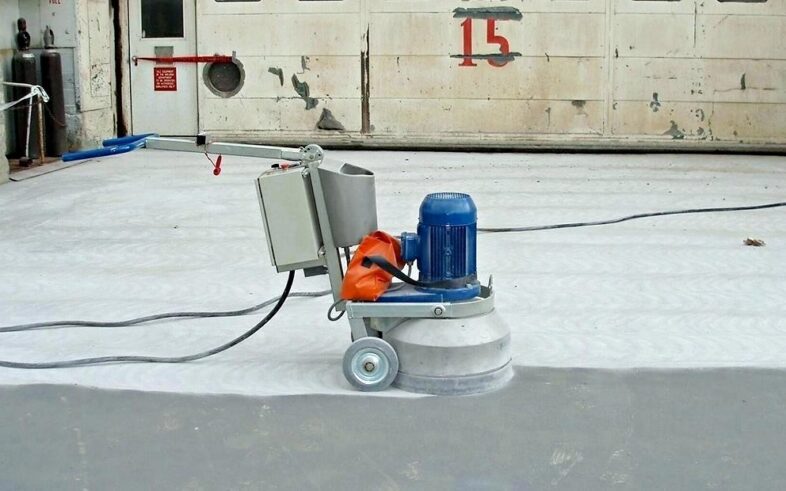
Concrete Floor Resurfacing
Concrete resurfacing is a way to refinish old concrete to look new again. A concrete coating is applied over the existing surface, offering a variety of color, texture and pattern options. This type of decorative concrete restoration can be done on driveways, patios, pool decks and even indoor floors.
REPLACE OR RESURFACE?
Conventional wisdom holds that old concrete must be torn out and replaced to improve the look. But there are many repair options available that will save you money, conserve resources, and eliminate disposal problems.
Resurfacing old concrete is perfect for:
- Fixing cracks
- Addressing discoloration
- Hiding surface imperfections
- Updating outdated finishes
- Covering unsightly concrete
Completely resurfacing concrete with an overlay is one way to upgrade the look, and you can choose from a wide variety of color and pattern options. If your concrete is in good condition but just needs a facelift, you can also stain, stencil or engrave it to improve the appearance. Here, we tell you all you need to know about restoring existing concrete, including procedures, application techniques, and decorative options.
What is an acceptable surface to be resurfaced?
Small plastics shrinkage cracks or crazing cracks can be covered by the polymer prime coat and base coat of the resurfacing material. Larger cracks must be repaired.
In any case, the underlying concrete for a resurfacing project must be sound. It is not feasible to resurface concrete that is heaving, has severe cracks, or is damaged due to freeze/ thaw damage. Resurfacing will not solve underlying soil problems.
Before sealing or re-sealing concrete that has already hardened, the surface must b well cleaned to ensure good product performance. Removal of dirt, oil, and other containment is necessary. Work slowly and steadily. Clean on section at a time before moving to the next. Following a a random washing pattern may result in uneven streaks after the concrete dries. Spot clean stains or oil-soaked areas, as sealing over these spots may result in poor adhesion or inadequate penetration of the product.
Allow the concrete to dry thoroughly before applying a sealer. Following a wash, there may be a significant amount of water left in the concrete even though the surface may appear dry. Any residual curing compounds need to be chemically stripped or mechanically removed before sealing. On stamped concrete with powdered release it is essential that 75% or more of the powdered release be removed prior to sealing, especially on high traffic spots.
Steps for changing your humidifier’s
CONCRETE RESURFACING OPTIONS
When resurfacing concrete, you can get any look you want. Here are some popular options:
- Stamped concrete overlays
- River rock or pebble coating
- Cool deck finishes
- Epoxy coatings with color flakes or metallic pigments (garages)
- Spray down texture coatings
- Broom finish applications
- Integral or topically applied color
- Stenciled patterns or hand carved designs
DOES CONCRETE RESURFACING LAST?
If you use a high-quality resurfacing product and have it professionally installed, you can expect it to last 10 years or more. Some contractors have even seen resurfacing last 25 years! But if you go with a DIY resurfacing kit from a big box store, they don’t last as long.
Proper cleaning, maintenance and protection go a long ways to making your new surface long-lasting. Make sure to have your concrete sealed, and then reseal as needed.
PREPARING CONCRETE FOR RESURFACING
The most critical factor when covering concrete with an overlay is to prepare the substrate properly. Overlays are designed to adhere tenaciously to existing concrete. But they must have a clean, solid base to grasp on to. That’s why overlooking the prep work, or not doing the job thoroughly, is the most common cause of overlay delamination and failure.
The basic steps in surface preparation include:
- Cleaning the concrete to remove all substances that could inhibit the ability of the overlay to bond, such as dirt, oil and grease. It’s also necessary to strip away any coatings, sealers or paints that may have been applied to the concrete.
- Removing any unsound concrete, such as minor spalling, scaling or delamination, down to solid concrete.
- Filling active cracks so they don’t mirror through to the overlay. Typically any cracks equal to or wider than the width of a credit card will require repair. (See steps in repairing cracks for a concrete resurfacing job.)
- Profiling, or roughening, the concrete surface to improve the “grip” of the overlay.
Using a machine that mechanically abrades the concrete, such as a grinder or shotblaster, is one of the most effective ways to prepare concrete substrates for resurfacing. This equipment not only removes most contaminants and unsound concrete, it will also leave behind a roughened surface profile.
Clearly, this is a simple overview. The procedures will vary depending on the condition and age of the concrete and the surface preparation guidelines recommended by the overlay manufacturer. This is a job best left to a professional who will be able to assess the condition of your existing concrete and determine the scope of work required to ensure good overlay bonding and performance.

